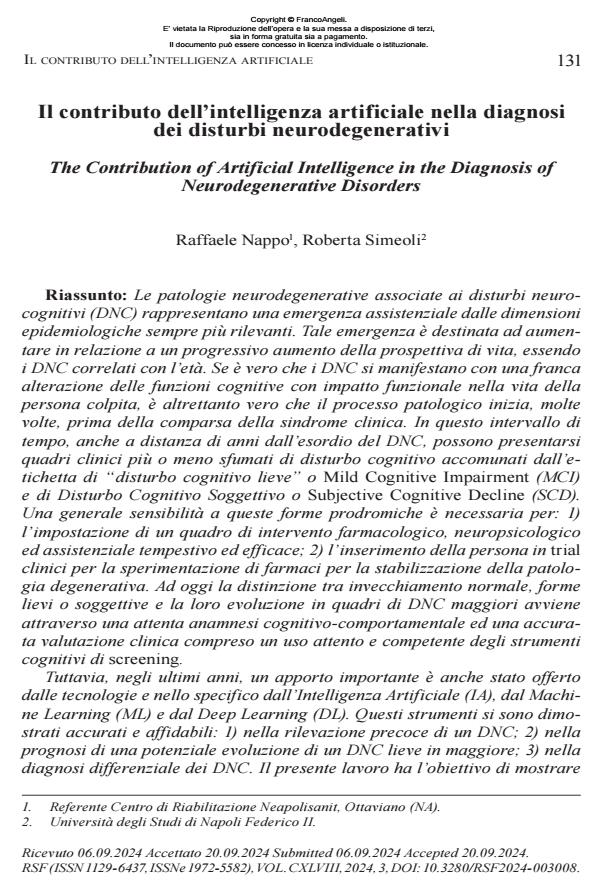The Contribution of Artificial Intelligence in the Diagnosis of Neurodegenerative Disorders
Journal title RIVISTA SPERIMENTALE DI FRENIATRIA
Author/s Raffaele Nappo, Roberta Simeoli
Publishing Year 2024 Issue 2024/3
Language Italian Pages 14 P. 131-144 File size 744 KB
DOI 10.3280/RSF2024-003008
DOI is like a bar code for intellectual property: to have more infomation
click here
Below, you can see the article first page
If you want to buy this article in PDF format, you can do it, following the instructions to buy download credits

FrancoAngeli is member of Publishers International Linking Association, Inc (PILA), a not-for-profit association which run the CrossRef service enabling links to and from online scholarly content.
Neurodegenerative diseases associated with neurocognitive disorders (NCDs) represent a growing healthcare emergency with increas- ingly significant epidemiological dimensions. This emergency is expected to intensify with the progressive increase in life expectancy, as NCDs are cor- related with age. NCDs are associated with clear cognitive dysfunctions that significantly impact the affected person’s life, the pathological process often begins before the onset of clinical syndrome. During this period, which can precede the onset of NCDs by years, subtle clinical signs of cognitive impair- ment may emerge, commonly named as Mild Cognitive Impairment (MCI) or Subjective Cognitive Decline (SCD). A general awareness of these prodromal forms is essential for: 1) establishing a timely and effective pharmacologi- cal, neuropsychological, and care intervention plan; 2) enrolling individuals in clinical trials for drugs aimed at stabilizing degenerative conditions.To date, the distinction between normal aging, mild or subjective forms, and their progression to more severe NCDs is achieved through careful cogni- tive-behavioral anamnesis and a thorough clinical assessment, including the skillful and competent use of cognitive screening tools.In recent years, an im- portant contribution has also been given by technology, specifically Artificial Intelligence (AI), Machine Learning (ML), and Deep Learning (DL). These tools have proven to be accurate and reliable: 1) in the early detection of NCDs; 2) in predicting the potential progression of mild NCDs to more severe forms; 3) in the differential diagnosis of NCDs.The present contribution aims to demonstrate to what extent the application of AI, ML, and DL can contrib- ute to a more effective and timely diagnosis of neurodegenerative disorders.
Keywords: Neurocognitive disorders, Dementia, Artificial Intelligence, Machine Learning, Deep Learning
- Neuromechanical network model Rosa Musotto, Giovanni Pioggia, in Frontiers in Physics 1656677/2025
DOI: 10.3389/fphy.2025.1656677
Raffaele Nappo, Roberta Simeoli, Il contributo dell’intelligenza artificiale nella diagnosi dei disturbi neurodegenerativi in "RIVISTA SPERIMENTALE DI FRENIATRIA" 3/2024, pp 131-144, DOI: 10.3280/RSF2024-003008